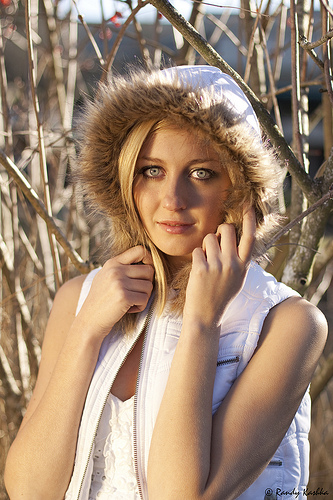Photo Tip – How To Create A Three Light Portrait Photography Set, With No Lights!
In today's portrait photography photo tip we are going to wrap up our discussions of the three light set with a quick review and an example of how to build a three light set - with no lights! Just because you don't have any studio lights, doesn't mean you can't shoot quality images.
Here is a quick review... Most good portrait photography requires three lights.
-
Light #1 - this is the main (key) light and is used to establish the lighting pattern and overall exposure settings.
-
Light #2 - this one is the fill light and is used (or not used) to fill in the shadows created by the main light. This light should be set at the same or less intensity as the key light so that it doesn't cast its own shadows.
-
Light #3 - this one is the background (separation) light and is used to visually separate the subject from the backdrop. It is placed behind the subject and can be aimed either at the background or at the subject.
When aimed at the backdrop, it creates a lighter area behind the subject so they don't blend into the background. Adding colored gels can make the backdrop any color you desire.
When aimed at the subject it creates a "halo" or "rim" of light around the subject. It's this rim of light that separates the subject from the background. The exposure value is generally a bit brighter than the main light.
The vast majority of amateur photographers never attempt the three light setup and their portrait photographs suffer because of it. Give it a shot! Once you are comfortable setting up and shooting with a three light set, you will never go back.
https://www.youtube.com/watch?v=gL8mhBtIAcoBy the way... if you have been avoiding the three light set because you don't have three lights - that's no excuse! Here is an example of a three light set...
First we set our model so that the sun is at her back (out of view of the camera). This will create a rim of light around her and visually separate her from the background. This is light #3.
Then we use a reflector placed in front and to the side of her. This will reflect the light from the sun back into her face and - depending on where we put it - will create whatever light pattern we want and establish the main exposure settings.

We can move the reflector closer or further away from our model to get the exposure we want. Ideally this is an exposure of half a stop or so less than the separation rim of light. This is light #1.
Another reflector set at the correct angle and distance from the model will fill in the shadows and become our fill light - light #2.
The above three light set is easy to create - costs next to nothing - and will give you professional quality portrait photography. Add in the fact that commercially made reflectors can fold up to a very small size and you can toss a few into the trunk of your car and you will always have them available!

Michelle by Randy Kashka on flickr (licensed CC-BY-ND)
Your mission - should you decide to accept it - is to give it a try. Practice this until you are comfortable working with a three light set - THEN go out and buy whatever lighting equipment you want. You'll know what you need and it won't end up in the closet where you store all your unused photo gadgets!
Today's portrait photography photo tip is that you don't need actual lights to create a three light portrait photography set! Reflectors and the sun will do the job very nicely!




